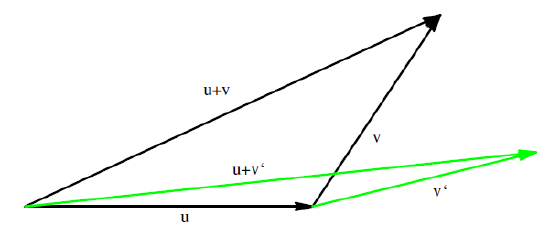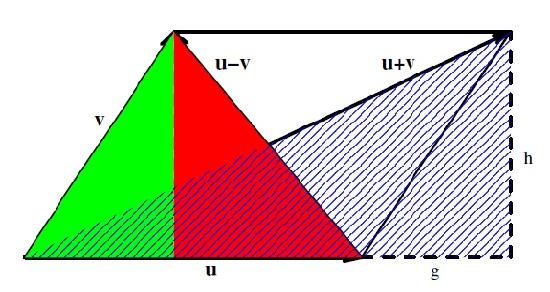9.3: Orthogonality
( \newcommand{\kernel}{\mathrm{null}\,}\)
Using the inner product, we can now define the notion of orthogonality, prove that the Pythagorean theorem holds in any inner product space, and use the Cauchy-Schwarz inequality to prove the triangle inequality. In particular, this will show that ‖v‖=√⟨v,v⟩ does indeed define a norm.
Definition 9.3.1. Two vectors u,v∈V are orthogonal (denoted u⊥v) if ⟨u,v⟩=0.
Note that the zero vector is the only vector that is orthogonal to itself. In fact, the zero vector is orthogonal to every vector v∈V.
Theorem 9.3.2. (Pythagorean Theorem). If u,v∈V, an inner product space, with u⊥v, then ‖⋅‖ defined by ‖v‖:=√⟨v,v⟩ obeys
‖u+v‖2=‖u‖2+‖v‖2.
Proof. Suppose u,v∈V such that u⊥v. Then
‖u+v‖2=⟨u+v,u+v⟩=‖u‖2+‖v‖2+⟨u,v⟩+⟨v,u⟩=‖u‖2+‖v‖2.
Note that the converse of the Pythagorean Theorem holds for real vector spaces since, in that case, ⟨u,v⟩+⟨v,u⟩=2Re⟨u,v⟩=0.
Given two vectors u,v∈V with v≠0, we can uniquely decompose u into two pieces: one piece parallel to v and one piece orthogonal to v. This is called an orthogonal decomposition. More precisely, we have
u=u1+u2,
where u1=av and u2⊥v for some scalar a∈F. To obtain such a decomposition, write u2=u−u1=u−av. Then, for u2 to be
orthogonal to v, we need
0=⟨u−av,v⟩=⟨u,v⟩−a‖v‖2.
Solving for a yields a=⟨u,v⟩/‖v‖2 so that
u=⟨u,v⟩‖v‖2v+(u−⟨u,v⟩‖v‖2v).
This decomposition is particularly useful since it allows us to provide a simple proof for the Cauchy-Schwarz inequality.
Theorem 9.3.3 (Cauchy-Schwarz inequality). Given any u,v∈V, we have
|⟨u,v⟩|≤‖u‖‖v‖.
Furthermore, equality holds if and only if u and v are linearly dependent, i.e., are scalar multiples of each other.
Proof. If v=0, then both sides of the inequality are zero. Hence, assume that v≠0, and consider the orthogonal decomposition
u=⟨u,v⟩‖v‖2v+w
where w⊥v. By the Pythagorean theorem, we have
‖u‖2=‖⟨u,v⟩‖v‖2v‖2+‖w‖2=|⟨u,v⟩|2‖v‖2+‖w‖2≥|⟨u,v⟩|2‖v‖2.
Multiplying both sides by ‖v‖2 and taking the square root then yields the Cauchy-Schwarz inequality.
Note that we get equality in the above arguments if and only if w=0. But, by Equation (9.3.1), this means that u and v are linearly dependent.
The Cauchy-Schwarz inequality has many different proofs. Here is another one.
Alternate Proof of Theorem 9.3.3. Given u,v∈V, consider the norm square of the vector u+reiθv:
0≤‖u+reiθv‖2=‖u‖2+r2‖v‖2+2Re(reiθ⟨u,v⟩).
Since ⟨u,v⟩ is a complex number, one can choose θ so that eiθ⟨u,v⟩ is real. Hence, the right hand side is a parabola ar2+br+c with real coefficients. It will lie above the real axis, i.e. ar2+br+c≥0, if it does not have any real solutions for r. This is the case when the discriminant satisfies b2−4ac≤0. In our case this means
4|⟨u,v⟩|2−4‖u‖2‖v‖2≤0.
Moreover, equality only holds if r can be chosen such that u+reiθv=0, which means that u and v are scalar multiples.
Now that we have proven the Cauchy-Schwarz inequality, we are finally able to verify the triangle inequality. This is the final step in showing that ‖v‖=√⟨v,v⟩ does indeed define a norm. We illustrate the triangle inequality in Figure 9.3.1.

Figure 9.3.1: The Triangle Inequality in R2
Theorem 9.3.4. (Triangle Inequality). For all u,v∈V we have
‖u+v‖≤‖u‖+‖v‖.
Proof. By a straightforward calculation, we obtain
‖u+v‖2=⟨u+v,u+v⟩=⟨u,u⟩+⟨v,v⟩+⟨u,v⟩+⟨v,u⟩=⟨u,u⟩+⟨v,v⟩+⟨u,v⟩+¯⟨u,v⟩=‖u‖2+‖v‖2+2Re⟨u,v⟩.
Note that Re⟨u,v⟩≤|⟨u,v⟩| so that, using the Cauchy-Schwarz inequality, we obtain
‖u+v‖2≤‖u‖2+‖v‖2+2‖u‖‖v‖=(‖u‖+‖v‖)2.
Taking the square root of both sides now gives the triangle inequality.
Remark 9.3.5. Note that equality holds for the triangle inequality if and only if v=ru or u=rv for some r≥0. Namely, equality in the proof happens only if ⟨u,v⟩=‖u‖‖v‖, which is equivalent to u and v being scalar multiples of one another.
Theorem 9.3.6. (Parallelogram Law). Given any u,v∈V, we have
‖u+v‖2+‖u−v‖2=2(‖u‖2+‖v‖2).
Proof. By direct calculation,
‖u+v‖2+‖u−v‖2=⟨u+v,u+v⟩+⟨u−v,u−v⟩=‖u‖2+‖v‖2+⟨u,v⟩+⟨v,u⟩+‖u‖2+‖v‖2−⟨u,v⟩−⟨v,u⟩=2(‖u‖2+‖v‖2).
Remark 9.3.7. We illustrate the parallelogram law in Figure 9.3.2.

Figure 9.3.2: The Parallelogram Law in R2
Contributors
- Isaiah Lankham, Mathematics Department at UC Davis
- Bruno Nachtergaele, Mathematics Department at UC Davis
- Anne Schilling, Mathematics Department at UC Davis
Both hardbound and softbound versions of this textbook are available online at WorldScientific.com.


